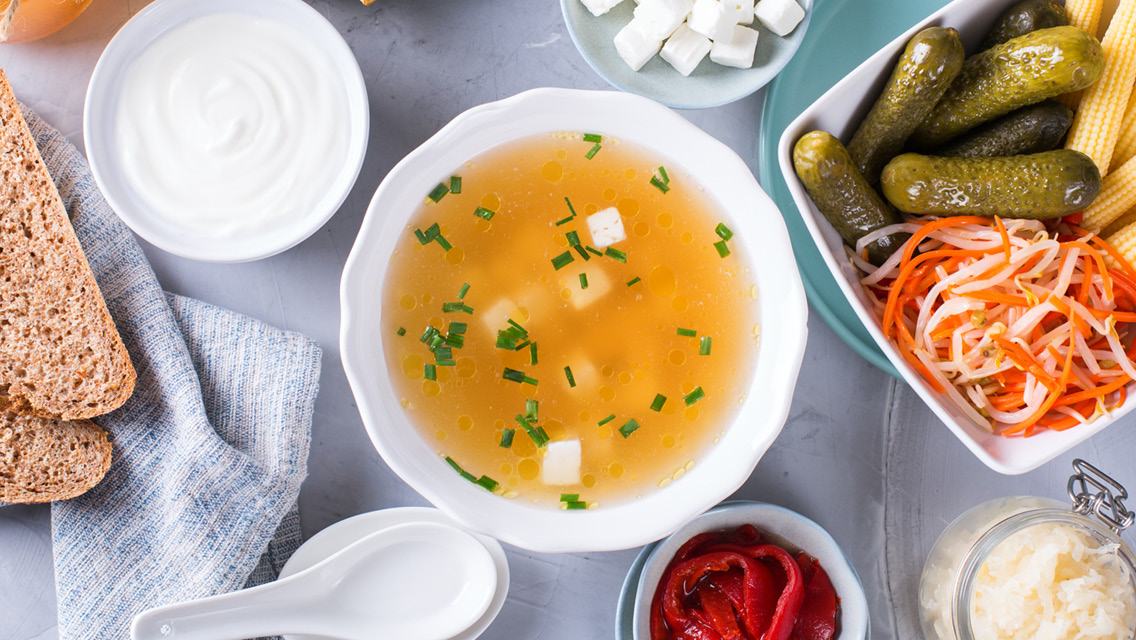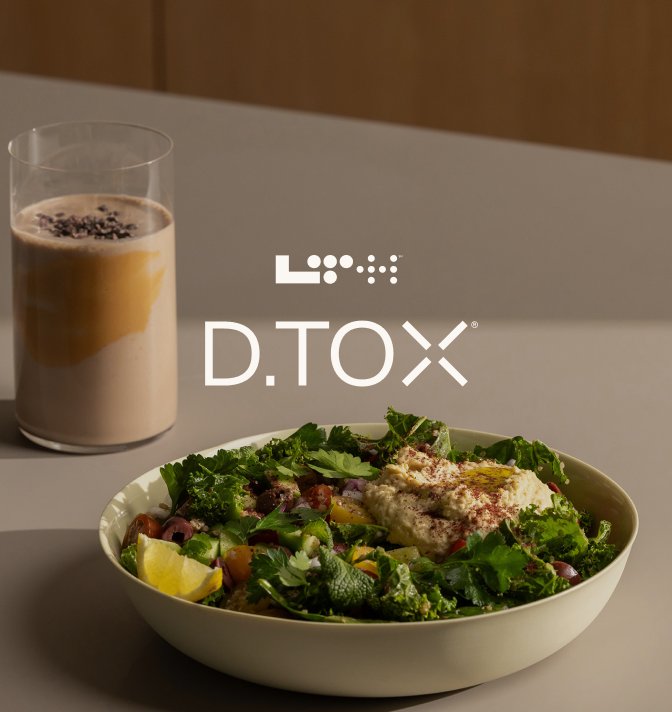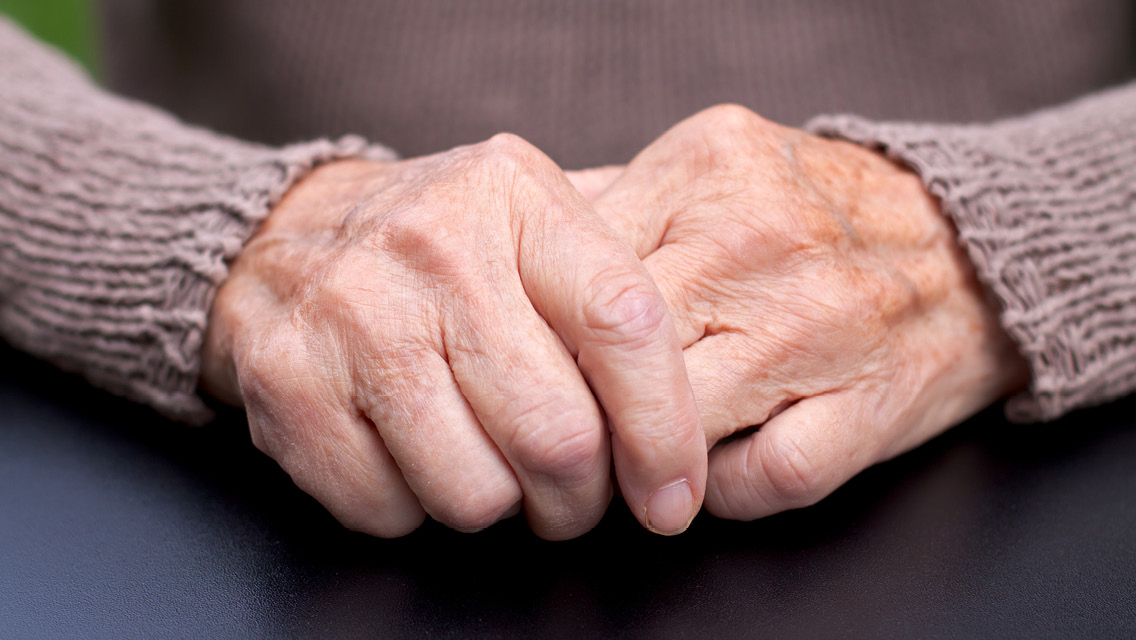When your digestive system is acting up, identifying and avoiding problem foods is often a vital first step to relief. But all this attention to exclusion leaves a couple of key questions unanswered: What can a person eat during rough digestive times? And do certain foods help resolve issues while building gut health and resilience?
Here’s the good news: Food is not the enemy when digestive issues arise, even though it can feel that way. Whether you suffer from ulcers, acid reflux, leaky gut, or irritable bowel syndrome (IBS) — or routinely encounter some undiagnosed gut distress — you can choose foods that promote healing, fortify digestive health, and support the entire gastrointestinal (GI) ecosystem.
It Starts With Goodbye
If you regularly experience bloating, reflux, stomach pain, or bowel irregularity, your gut likely does need some care. A healthcare practitioner literate in GI issues can help you identify the root causes of your distress and map out the first phase of your healing process. This will likely include an elimination diet.
“So many different foods trigger people, and there is so much confusion over what gives them digestive distress,” says Hilary Boynton, coauthor of The Heal Your Gut Cookbook. “That is what makes an elimination diet so valuable.”
Elimination diets often relieve symptoms, but most are not meant to last forever. “I do not see these protocols as lifelong ways of eating,” says clinical nutritionist Liz Lipski, PhD, author of Digestive Wellness. “Instead, it is a therapeutic trial to see if changing your diet makes you feel better, to allow the gut to heal, and to give you diagnostics.”
The exceptions, she says, are common allergens, such as gluten, dairy, and eggs. These are more likely to cause long-term trouble for those who can’t tolerate them. Giving up these foods can make people feel so much better that it’s worth the sacrifice.
What Foods Help Repair the Gut?
If you’ve experienced a period of gut distress, your body may begin to associate food with discomfort. You may even notice yourself dreading eating. But once you’ve identified and eliminated trigger foods, an array of healing foods may help keep symptoms in check and support a more resilient gut over time.
An added bonus: These beneficial foods also support a more resilient mind. “The gut microbiome can have dramatic effects on mind and mood,” says integrative nutritionist Kathie Swift, MS, RDN, LDN. This is due to the strong connection between the gut and the brain through the vagal nerve and hypothalamus-pituitary-adrenal axis.
“We can shift the microbial messages to the brain using food,” she explains. “It’s food as psychological medicine.” (For more on this relationship, see “Healthy Gut, Healthy Brain.”)
Now let’s meet some of the foods that are most medicinal for the gut.
1. Dandelion Greens
Good for: Fat digestion
Dandelion greens enhance fat digestion in two ways: They’re both a choleretic, meaning they stimulate bile production, and a cholagogue, an agent that increases bile flow.
“If a person feels like they are not digesting fat well, a cholagogue can help,” says Lipski. Dandelion greens may also promote bowel regularity and improve blood-sugar balance. They are anti-inflammatory and anticarcinogenic, too.
How to Eat More: Dandelion is notoriously bitter, so if you’re keen on bitter flavors, try the greens in salads, as a base for pesto, or sautéed or braised with garlic.
You can also drink roasted-dandelion-root tea — its pleasant bitterness makes it an excellent coffee substitute. If you have a sweeter palate, try adding dandelion greens to a smoothie with berries, ginger, or green apples.
Cautions: Since dandelion stimulates bile production, those with gallstones or bile-duct issues should consult a healthcare practitioner before consuming large quantities.
(Find recipes and simple ways to use this powerful plant at “Dandelion Greens.”)
2. Cabbage Juice
Good for: Peptic ulcers
In 1949, researcher Garnett Cheney, MD, wanted to see if cabbage juice could help heal ulcers; earlier animal studies had shown promise. So he asked study participants to drink a liter of cabbage juice daily and then tracked how long it took their ulcers to heal compared with people who tried conventional therapy.
The results were astounding: Those who drank cabbage juice saw their ulcers heal in an average of nine days. Earlier studies suggested that conventional treatment typically healed the ulcers in 42 days.
Cheney didn’t know what we know today — that most ulcers are triggered by the bacteria Helicobacter pylori — but he discovered something that research confirmed some 60 years later. In one animal study, cabbage juice showed “significant inhibitory effects” on H. pylori. Plus, cabbage, like all crucifers, has a vast array of health-promoting properties, including supporting the liver’s detox efforts and helping to guard against cancer.
How to Get More: Cabbage juice is surprisingly palatable when it’s combined with juice from other vegetables and fruits, like beets, parsley, and lemons. It may be hard to drink a liter a day, Lipsky notes, “but if you get in a little bit every day, you will end up with some benefit.”
Eating cabbage is easier and also offers plenty of gut-healing benefits: Add it to soups and stir-fries, sauté it in butter and spices, or roast it in the oven — cooking softens cabbage’s astringent flavor. And sauerkraut offers double benefits as a fermented food with probiotics.
Cautions: If you suffer frequent bloating and gas, cabbage may exacerbate those symptoms, especially if it’s eaten raw. If this is true for you, test to see if cooking cabbage makes it more digestible.
3. Fermented Foods
Good for: Gut dysbiosis, leaky gut, constipation, diarrhea, maintaining long-term gut health, building digestive resilience
Sauerkraut, kimchi, yogurt, kefir, and other fermented fare are rich in probiotics, which support the health of the gut microbiome. Probiotics have also been shown to help correct gut dysbiosis (an unhealthy ratio of bad bacteria to good bacteria in the GI tract); protect the delicate gut lining; improve transit time, regularity, and stool consistency; and treat and prevent antibiotic-associated diarrhea.
In other words, the gut-healing potential of fermented foods is both broad and significant.
Some research suggests they may also ease IBS symptoms and prevent diverticulitis (inflammation or infection of the pouches that can form in your intestines), but results are inconclusive. Use your body’s response as a guide when deciding whether or not to eat fermented foods. If they trigger problems, avoid them (at least for now). If not, enjoy them to your heart’s content; their probiotics make them a boon for gut health.
How to Eat More: Ferments such as sauerkraut and kimchi are great counterpoints to anything rich or starchy. They also add bright flavor to sandwiches and stir-fries — especially those with a creamy sauce like peanut or coconut.
For breakfast, plain yogurt can be topped with berries and nuts; for lunch or dinner, it can be used as a garnish for curries and other spicy dishes.
Those who love tangy flavors can enjoy drinks like kvass and kombucha. Just be on the lookout for added sugars, which can negate some of the benefits of fermentation.
Cautions: Some functional-medicine practitioners argue that gut conditions like SIBO (small intestinal bacterial overgrowth) don’t need more microbes introduced into the ecosystem. The way to tell if that’s true in your case is to track symptoms: If you notice an uptick in bloating after consuming fermented foods or drinks, ease off.
No eating protocol is healthy for all people, all the time. “I have patients who get so wrapped up in something that they’ve read is healthy that they can’t give up eating it even if it is making them miserable,” says Michael Ruscio, DC, author of Healthy Gut, Healthy You.
He cautions that “these things are very individual” and if you feel worse when you eat a specific food — even a gut-friendly superstar — avoid it for now.
(Make your own fermented foods with these eight recipes.)
4. Bone Broth
Good for: Leaky-gut syndrome, long-term gut health
Sipping bone broth can be soothing when your gut is overactivated; it may also be healing. “We know that bone broth is high in collagen, minerals, glucosamine, and chondroitin — compounds that alkalize and nourish the body,” says Lipski. “They seem to be really healing for the gut.”
When your digestion isn’t optimal, adding some broth to your diet is a great way to get more vitamins and minerals — and make the most of them. Research on collagen is mixed, but some experts suggest it may improve tight junctions in the gut by helping to rebuild damaged tissue.
How to Eat More: Drink it like tea, use it as a base for soups and stews, add it to chili, use it as a cooking liquid for grains or as the base for a risotto.
Cautions: If your body overproduces histamine (a condition known as mast cell activation syndrome), steer clear of bone broth. “Bone broth can trigger a histamine response,” says Lipski. (For more on histamines, visit “What You Need to Know About Histamine Intolerance.”)
(Make your own bone broth with this easy recipe.)
5. Garlic
Good for: Peptic ulcers, food poisoning and other acute gut infections, gut dysbiosis
The phytonutrient content of garlic is so impressive that functional-medicine physician Terry Wahls, MD, suggests that two cloves are as nutritionally potent as a full cup of any other vegetable. Garlic has been shown to kill H. pylori, the bacteria that causes a majority of peptic ulcers, and research at Washington State University found that garlic was 100 times more effective than two popular antibiotics in killing Campylobacter bacterium, one of the most common culprits behind food poisoning. (This effect appears to be attributable to garlic’s sulfur compounds.)
Garlic also contains prebiotics, a type of fiber that feeds good gut bacteria. So if you are suffering from an imbalance of bacteria in the gut microbiome, know that garlic works as both an antibiotic (killing off hostile bacteria) and a prebiotic (feeding good bacteria).
How to Eat More: Garlic is extremely versatile. Add it to sautés and stir-fries; crush it into salad dressing; include it in sauces; enjoy it raw in pesto. Raw garlic delivers the most potent antimicrobial benefits. When heating, add it just before taking a dish off the flame. Either way, try to chop it at least 10 minutes before cooking it; this triggers an enzyme reaction that boosts its healthy compounds.
Cautions: Garlic is a high-FODMAP food — an acronym for “fermentable oligo-, di-, monosaccharides, and polyols.” This group of carbohydrates can sometimes trigger bloating and stomach pain. If you associate these symptoms with eating garlic, you may be intolerant of some high-FODMAP foods.
Consider trying a low-FODMAP diet, which temporarily eliminates foods with high levels of these substances. (For more on the low-FODMAP diet, see “Can An Elimination or Low-FODMAP Diet Treat IBS?”.)
(Try our “Honey-Fermented Garlic” recipe for a pungent treat that is full of bacteria to aid your gut microbiome.)
6. Chia, Flax, and Hemp Seeds
Good for: Constipation, gut inflammation
Chia seeds, flaxseeds, and hemp seeds are excellent sources of fiber, a healing nutrient for the gut. “Fiber is the key nourishment for the gut microbes, which feast on it and transform it into fatty acids that work at the cellular level [to improve health],” Swift explains.
This fiber-to-fatty-acid transformation also exerts a positive influence on the gut–brain axis. “A daily dose of fiber is hope delivered straight to the brain,” she adds.
Flaxseeds have been shown to reduce inflammation in the gut and improve glucose tolerance. Both flaxseeds and chia seeds are rich in omega-3 fatty acids, which help tamp down inflammation systemwide. And the added fiber is good for maintaining colon health.
How to Eat More: All three seeds add protein, fiber, and essential fatty acids to your morning smoothie. Toasted hemp seeds add crunch to salads. Ground flaxseeds and chia seeds can be mixed with water and used to replace eggs to bind baked goods. (Learn how at “How to Make a Chia or Flaxseed Egg.”)
Chia seeds are great thickeners: Mix them with coconut milk, berries, and a little honey or maple syrup for a tasty pudding.
Cautions: Health experts once universally cautioned people who suffered from diverticulitis to avoid eating seeds because they might get stuck in the diverticula (the pouches that can form in the colon) and trigger an infection. That view is changing, however, as the link between diverticulitis and seed consumption is unproven. Err on the side of caution and avoid seeds if you are recovering from a severe flare-up.
7. Ginger
Good for: Motility issues, nausea, functional dyspepsia, flatulence, bloating, belching
Functional dyspepsia occurs when food sits in the stomach for too long for no apparent structural reason — and it can stir up trouble. People with functional dyspepsia report feeling full after eating only a small portion, and they regularly experience postmeal bloating, burping, and flatulence.
If you’re troubled by these symptoms after eating, ginger might help: Studies have shown it speeds up gastric emptying. Ginger has also been well studied for its antinausea effects; it’s long been used as a treatment for motion sickness and morning sickness.
How to Eat More: Ginger adds mild heat to dishes both savory and sweet. Fresh ginger is common in stir-fries and curries, but it’s also terrific in dressings and marinades; adds a kick to green smoothies and juices; and livens up baked goods. Boiling fresh ginger for tea makes a great postmeal digestif.
Cautions: Eating a large amount of ginger may trigger mild heartburn or cause diarrhea.
So even when your digestion isn’t optimal, there are still foods you can enjoy. Use specific fare to soothe flare-ups, and other foods to repair your gut over time.
Knowing you have a list of supportive, go-to options can help you stay strong and nourished — and get you on the road to healing.
5 Gut-Healing Supplements
These supplements provide extra support when you’re experiencing digestive symptoms — or working to keep them at bay.
L-glutamine: The most abundant amino acid in the body, L-glutamine plays an important role in maintaining the gut lining. It can help repair the tight junctions between the cells in the lining of the GI tract that are damaged by leaky gut syndrome.
Omega-3 fatty acids: Omega-3s have been shown to help improve the balance of good and bad bacteria in the gut microbiome in people with inflammatory bowel disease, as well as boost production of anti-inflammatory compounds that help heal leaky gut.
Probiotics: There’s substantial evidence that probiotics can help with diarrhea, constipation, ulcerative colitis, IBS, and other functional GI disorders such as SIBO.
Still, some people with GI distress report feeling worse on a probiotic, says functional-medicine practitioner Michael Ruscio, DC. If that’s you, listen to your body and take a break — or try a different microbial strain. (For more on finding the right probiotic, see “The Probiotics Puzzle.”)
Mastic gum: Research has found that mastic gum (a medicinal tree resin, usually taken orally in capsule form) can significantly improve the symptoms of functional dyspepsia, a condition where food stays in the stomach too long. It can also help fight H. pylori, the main cause of peptic ulcers, and help ease symptoms of Crohn’s disease.
Digestive enzymes: Supplemental enzymes have been shown to help with a variety of postmeal discomforts, including diarrhea, bloating, and flatulence. People with functional gastrointestinal disorders or leaky gut syndrome may also benefit from digestive enzymes.
Did You Know?
11%: Percentage of Americans suffering from a chronic digestive disease. Among adults age 65 and older, that number jumps to 35 percent.
16%–20%: Percentage of Americans dealing with irritable bowel syndrome. “Every time I go to a party, meet someone new, and tell them what I do, they mention a problem with their gut. I’d estimate that the number of people who have some type of problem with their gut is at least three times as high [as the reported number],” says functional-medicine practitioner Michael Ruscio, DC.
10%: Percentage of Americans who will have a duodenal ulcer in their lives.
Learn More
The gut microbiome plays a crucial role in our overall well-being, from digestion and immune function to mood and mental health. You can learn more about the importance of gut health by exploring our collection of articles.





This Post Has 3 Comments
It’s time to stop recommending chia seeds as they contain lectins and there are studies published that they cause inflammation.
This and your previous article on GERD are the best articles I’ve ever read on gut health. This is the level of information I have been looking for and not finding. I am a fifty-year nurse with MSN ( mental health) and I have searched Mayo, etc. I suffer from GERD and reluctantly take ongoing PPI OTC daily or I suffer discomfort. My PCP has no suggestions and my GI consult and endoscopy with a Vanderbilt specialist who still practices at Cleveland Clinic answered none of my questions though ruled out any evidence of esophageal cancer. Physicians look for already developing disease. I and the public seek prevention.
I will be looking for a nutritionist guide to seek better digestive healing and disease prevention over the next year.
Much thanks,
Margie Gale RN, MSN, CEAP
Thank you for mentioning FODMAP. Their recommendations have helped me with my gut problems.